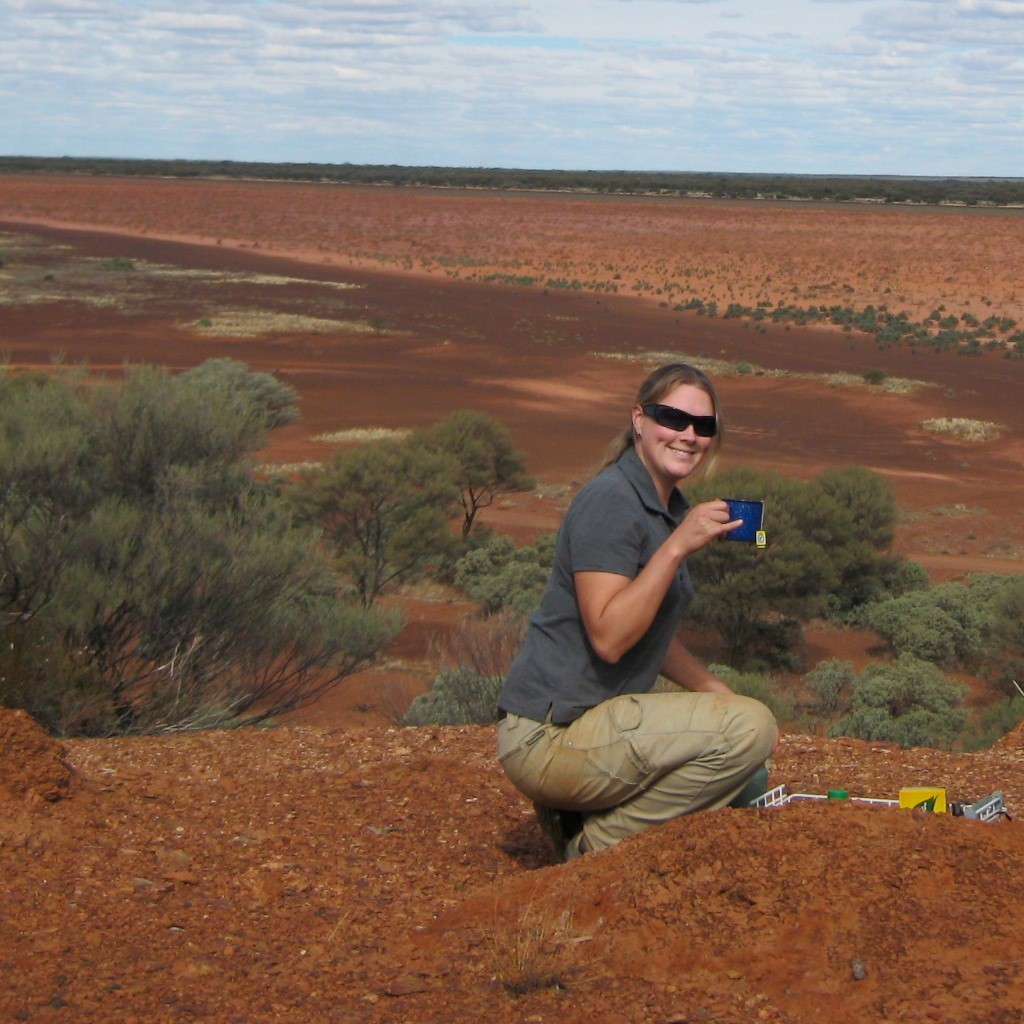Judy Dunlop
Judy Dunop rivals Indiana Jones
Judy Dunlop is an adventurer with a tender heart. Her family had to leave a circus show when she was 4 because she yelled with great emotion at the lion tamer to stop teasing the lion. It was a sign of things to come: courage and determination have got her through some tough adventures. Her breadth of experience with many animal species and environments is remarkable. Judy not only tames lion tamers, she also traps, tracks, translocates, and studies many species of wildlife. Poor Indiana Jones now looks like a wimp. Enjoy meeting Judy.
Topa Petit, Membership Officer
Below: Judy with golden bandicoot (photo: Brent Johnson)

History
I grew up in a farming family and have always been surrounded by animals. My parents and I hand-raised animals, put out water for the wild ones, looked after injured ones, and buried any that didn't make it in the garden. I tended 4 aquariums in my room through high school. It seemed a natural progression to study Zoology at uni!
Doing volunteer work within the UWA Zoology Department, and what was then the Department of Conservation and Land Management (CALM) WA, solidified my interest in terrestrial wildlife research. I'm very fond of the arid zone and am constantly amazed at the abundance of life that hangs on through such tough conditions out there. Although I've done a fair bit of work in the forests in SW WA, I feel much more at home in the arid zone.

Above: cuppa at Lorna Glen (photo Judy Dunlop)
Interesting research/projects
My PhD (nearly submitted!) was examining translocated golden bandicoots and boodies. I looked at some parasite impacts, as well as the ecology and survivorship of the translocated populations. It was a fortuitous study because both species are peanut butter addicts so I had incredible recapture rates and trap success (~80% for both). It was interesting to make the connection between collecting in the field, taking samples to the lab and combing results from both to gain a greater insight into ecological processes.
My first roles were as a general field dogsbody. I helped on wetland botanical projects, let mulgara bite me while they had radio-collars put on, searched for snakes in wetlands and on islands, trapped heath mice, possums, chuditch and did plenty of data entry. One of my first paid jobs was crowbarring and dynamiting pits in for the Pilbara biological survey, thinking "if I can do this, I can do anything".
I am lucky enough to have spent a lot of time working on fauna translocation projects with the Department of Parks and Wildlife, so have had the privilege of working with many threatened mammals: bilbies, mulgara, chuditch, brushtail possums, mala, golden bandicoots, boodies and now northern quolls.
Two career highlights of this work
After reintroducing 107 bilbies at Lorna Glen (put your finger in the centre of a map of WA - that's Lorna Glen) and spending an awful lot of time radiotracking them, or picking up their carcasses bearing signs of cat predation, we finally caught our first "cleanskin" subadult. This was an animal born onsite and surviving independently of its mother. It signified the hope we can have of native animals persisting in the wild with cat control rather than behind fences. The local Martu ladies called me "grandma bilby" for this moment!
Another highlight was our work on boodies (burrowing bettongs, photo below is by Judy Dunlop). The boodie has been extinct on mainland WA for about  60 years. European settlers described boodies as pretty annoying neighbours. They ate crops of peas and beans, consumed cellar stores of flour, sugar, pork, candles and even soap. Their centralised warrens made them very easy to find, so became easy targets for shooting, poisoning, trapping or killing with farm dogs. Cats and foxes would have been able to stake out a warren each night until no boodie remained. Their warrens, previously inhabited by thousands of generations of boodies, still dot the landscape, now inhabited by rabbits, goannas and even echidnas. Warrens in calcrete country are visible from satellite imagery. During this project, we released more than 160 boodies into old calcrete boodie warrens that had been empty since the 1960s. It was just awesome to see them take so quickly to these warrens, and a few weeks later it looked like explosions had been set off with all the huge spoil heaps around the place.
60 years. European settlers described boodies as pretty annoying neighbours. They ate crops of peas and beans, consumed cellar stores of flour, sugar, pork, candles and even soap. Their centralised warrens made them very easy to find, so became easy targets for shooting, poisoning, trapping or killing with farm dogs. Cats and foxes would have been able to stake out a warren each night until no boodie remained. Their warrens, previously inhabited by thousands of generations of boodies, still dot the landscape, now inhabited by rabbits, goannas and even echidnas. Warrens in calcrete country are visible from satellite imagery. During this project, we released more than 160 boodies into old calcrete boodie warrens that had been empty since the 1960s. It was just awesome to see them take so quickly to these warrens, and a few weeks later it looked like explosions had been set off with all the huge spoil heaps around the place.
A few other highlights
- being part of a rat eradication program on the Cocos Islands, enabling birds such as boobies, rails and frigates to nest  successfully again (photo by Judy Dunlop; rats travel among islands using ferries, so those are also baited)
successfully again (photo by Judy Dunlop; rats travel among islands using ferries, so those are also baited)
- helping with captures of wedge-tailed eagles to put satellite backpacks on them
- fauna surveys in a number of WA's most remote nature reserves - e.g. Karijini NP, Dundas NR, Lake Magenta NR
- being involved in community outreach "voluntourism" trips, where members of the public tag along with scientists to learn about the natural environment
Current projects
Currently I'm working on the endangered northern quoll in the Pilbara. We are trying to quantify the population dynamics of this species throughout the Pilbara region in the face of threats such as feral cats, habitat alteration due to grazing and changed fire regimes, and loss of habitat through mining of rocky areas, particularly iron ore. The Pilbara is a bit different to the rest of Australia for the northern quoll population because cane toads are not yet a threat there. My workmate and I joke that it is us two vs an area the size of Germany.

Above: quoll habitat in Pilbara (photo by Judy Dunlop)
Advice for people interested in Australasian mammalogy
Volunteer on other people's work! After my degree I spent a solid 8 months doing volunteer work for scientists in government and at universities before getting my first part-time casual position. This helped me to figure out what kind of work interested me, as well as meet a lot of people in the industry and learn some field skills. It's invaluable to learn how other people go about things - even parallel projects in different states have a lot to learn from each other. It's great to go and help others out and see a project through someone else's eyes. I still take volunteers on almost every trip and enjoy the variety and knowledge they have to share!
Post a comment
You must log in or register to post comments.
If you are visiting this form to renew your membership enter your email address and password below.
Click on the forgotten password option if you are not sure of your password.

